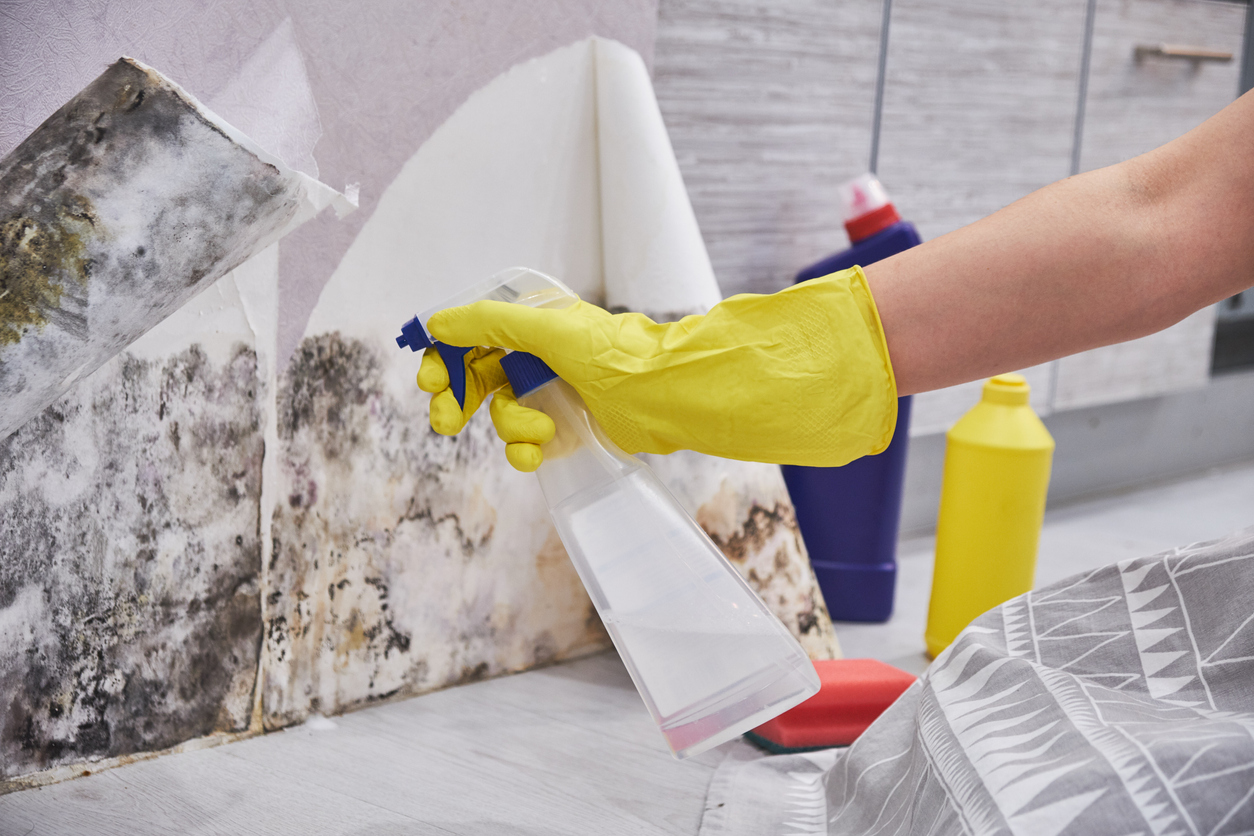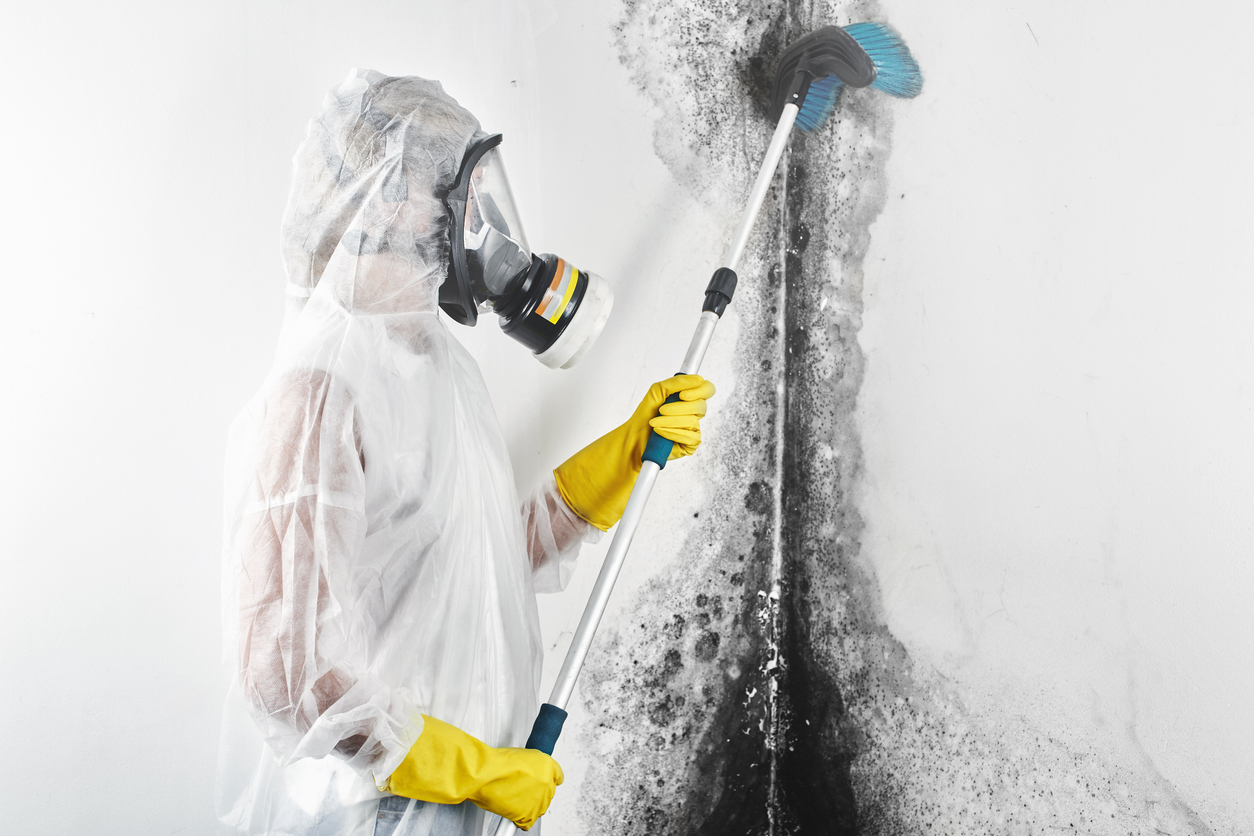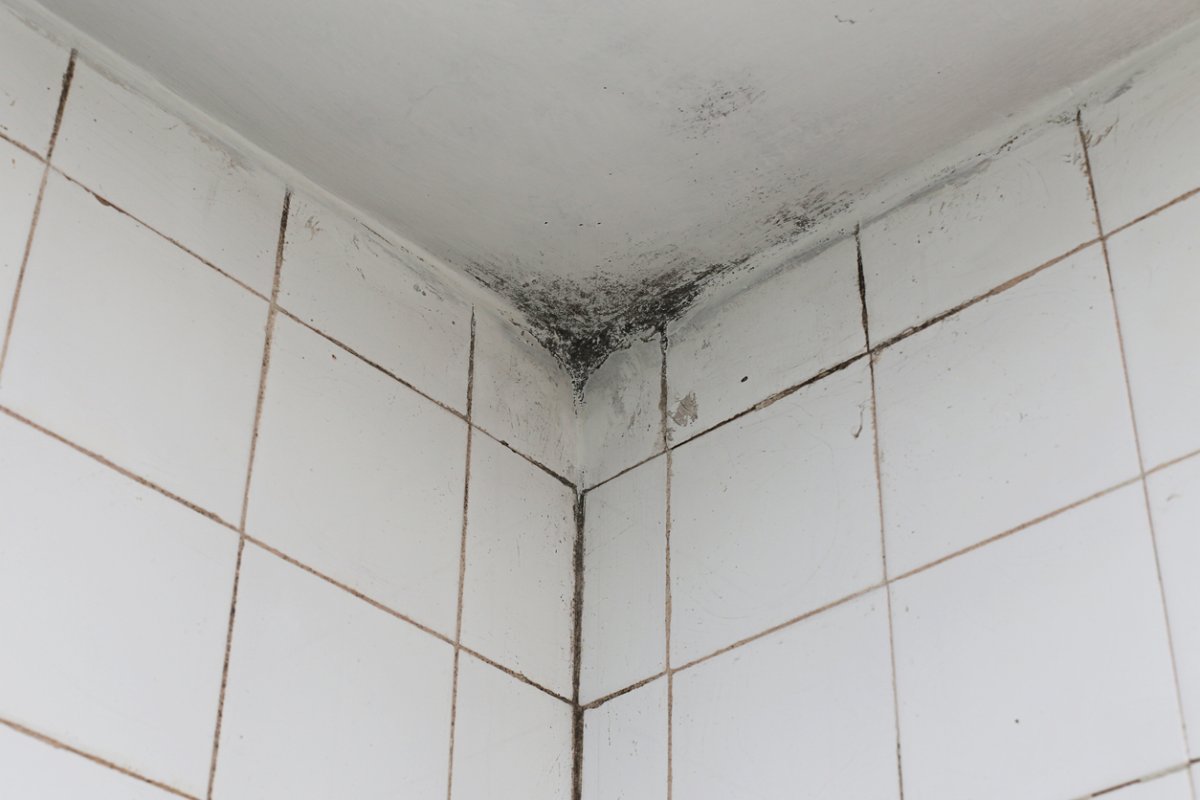We may earn revenue from the products available on this page and participate in affiliate programs. Learn More ›
What You Need to Know
- There are a variety of mold types that grow on walls, and some are more toxic than others. It’s a good idea to identify the mold before proceeding with cleaning.
- When cleaning mold, it’s recommended to wear protective gear like masks and long sleeves to protect yourself from spores.
- Household products like vinegar and bleach can be effective for removing mold from walls.
- If a mold problem persists or is widespread, it’s best to let a mold remediation specialist handle the removal.
Q: Ugh! I’ve recently discovered gross patches of mold on the walls in my bathroom. Is it dangerous? How do I get rid of it?
A: Splotches of mold growing on the walls or ceiling are an all-too-common problem in any area of the home where moisture levels tend to be high. While there are many places mold hides in a home, when it’s along a wall, it’s most often found either up high near the ceiling, down low near the floor, or creeping along edges of trim or baseboards. The question of how to get rid of mold on walls is a common one for those faced with unsightly blotches in the bathroom or elsewhere in their home.
It is most common to find mold on walls in the bathroom, especially if there are frequently used showers or tubs, but it can also affect damp basements, kitchens, or laundry rooms. If conditions are damp, ventilation is poor, and temperatures are high, then airborne, invisible mold spores—found virtually everywhere—happily settle in and grow. It’s vital for the home’s residents to learn how to kill mold on walls effectively (or hire professional mold remediation) before the problem becomes a major health hazard.
1. Before attempting to remove the mold from the walls, it’s important to identify the type of mold to determine how to remove it—and whether to call a pro to handle the task.
The most feared type of mold is Stachybotrys chartarum—more commonly referred to as black mold. According to the Centers for Disease Control and Prevention (CDC), black mold on walls or elsewhere in a home can cause chronic respiratory irritation, headaches, and persistent fatigue. It’s relatively common to find black mold in bathrooms due to the constant moisture and humidity. But there are plenty of other potential types of mold on walls, and many are of a much less toxic variety. Molds fall into three major categories in terms of health effects: allergenic, pathogenic, and toxigenic. Toxigenic molds are considered to be the most worrisome because they produce mycotoxins, which are highly hazardous. Black mold falls into this category. Allergenic molds can exacerbate respiratory problems in those who are allergic, and pathogenic molds are most dangerous for those with existing health conditions or weakened immune systems.
- Alternaria is a very common allergenic mold that is often found in showers. Those who are allergic may experience cold-like symptoms upon exposure.
- Aspergillus is a type of pathogenic mold that frequently grows following water damage. This type of mold can be deadly for those who are immunocompromised, and some Aspergillus varieties have even been linked to cancer.
- Aureobasidium is a rapidly growing allergenic mold common on walls underneath wallpaper. While it is often black, aureobasidium can appear in a variety of colors.
- Chaetomium is another type of mold that goes hand in hand with water damage. Chaetomium is an allergenic mold that looks like black mold due to its dark color.
- Mucor has 40 varieties, most of which are allergenic. One toxigenic variety called Mucor indicus is the most dangerous as it can cause fungal infections. Mucor is typically light in color and can grow to be an inch thick.
- Penicillium typically has a green or blue appearance. This kind of mold is allergenic and has the potential to cause severe inflammation in the heart or serious asthma symptoms.
- Serpula lacrymans is typically the culprit behind what is referred to as dry rot. This allergenic mold is found almost exclusively on wooden surfaces and does not pose a serious health risk in most cases.
- Trichoderma has 89 species, and one called Trichoderma longibrachiatum is often found in homes. Trichoderma is considered a toxigenic mold, but specific conditions must be present for it to produce mycotoxins.
- Ulocladium is a dark-colored allergenic mold that grows in parts of the home that are frequently exposed to water.
Testing for mold is the only way to know for sure which variety is growing. It’s best for residents to consult with an expert in mold remediation for professional cleaning services if there is mold inside the walls and not just on the surface. The good news is that many everyday mold problems can be cleaned up without professional help.
2. Assemble your cleaning supplies and make sure you have protective gear, such as old clothes, a face mask, gloves, and protective eyewear.
It’s generally a good idea to approach DIY mold removal with the utmost caution no matter what variety is being dealt with. At its most mild, mold exposure can cause symptoms that mimic seasonal allergies (such as coughing, skin rashes, and itchy eyes). These symptoms may last several days after the initial exposure. More serious cases could lead to what is called hypersensitivity pneumonitis, which is an inflammation of the lungs. In order to prevent these adverse effects, it’s important for individuals to wear the proper gear while cleaning mold. The CDC recommends wearing clothing that completely covers the body, including gloves and waterproof boots as well as an N95 respirator and goggles. It’s also a good idea to wear disposable coveralls that can be discarded afterward to avoid spreading spores. If any symptoms arise despite these precautions, it’s a good idea for the homeowner to stop and contact a professional to finish the job.
3. Open the windows in the room or use fans, such as bathroom or kitchen exhaust fans and standing fans, to properly ventilate the room.
Mold spreads by releasing spores that travel through the air, usually unseen. Wherever spores eventually settle, mold can begin to grow if conditions are right. When these spores are inhaled or come into contact with the skin, they can also be irritating or cause allergic reactions and infections. Mold is sure to release spores when it is disturbed in the cleaning process, but with proper ventilation, the spores will not stay concentrated in the affected area. Airflow is essential to stopping new mold growth, as mold thrives in damp and humid environments. Good ventilation can also help to eliminate the smell of mold from the home. It’s worth noting that bleach and other strong chemicals used to remove mold can be irritating, so allowing plenty of airflow in the room during the cleaning process can also prevent these fumes from becoming overwhelming. Ventilation may be a challenge for those cleaning mold on basement walls or in windowless bathrooms, but running a few box fans can help.

4. Prepare your cleaning solution and supplies, which could consist of vinegar, bleach, or mold remover, and apply to the walls; use a circular motion to work the solution into the surface with a sponge or brush.
Some of the best mold removers available commercially use ingredients such as bleach, ammonia, vinegar, and borax, but in many cases just one of these ingredients will suffice. The list of what kills mold doesn’t end there—other nontoxic mold removers include tea tree oil and grapefruit seed extract, which are even effective at getting rid of black mold. For those using bleach, a good approach is to mix a solution of one part bleach to three parts water in one of the best spray bottles, then thoroughly saturate the moldy areas of the wall. It’s a good idea to let the bleach soak into the mold on the walls for several minutes, then use one of the best bathroom scrubbers to remove the stains by scrubbing in a circular pattern. While bleach works well to kill surface fungus and remove the ugly marks on the walls caused by mold, it doesn’t penetrate deeply into the drywall, and so it leaves the mold’s “roots” undisturbed. That means the problem is likely to reoccur, sometimes within days.
Using vinegar for mold removal can be more effective than bleach at getting to the root of the mold problem. To try and kill mold beneath the surface, residents can spray undiluted white vinegar onto the affected area and let it dry. The vinegar smell is likely to dissipate once the surface is completely dry, but if this is a concern, adding a few drops of essential oil to the spray bottle may mask the scent. For those wondering what kills black mold on walls, the methods that have been outlined are likely to be effective in getting rid of Stachybotrys chartarum in addition to other common molds.
5. Let the wall air dry; once dry, check to see if any mold stains remain and repeat the process as needed.
After scrubbing the wall, it’s a good idea to let the surface dry before inspecting it for further stains. This process can be quickened by directing one or two fans at the wall, but it may take as long as 24 hours to dry completely. If it looks like there is still mold after the area has dried, repeating the cleaning once or twice will likely clear the stain. Since moisture is what causes mold on walls in the first place, it’s a good idea to keep fans directed at the area after the final clean until the wall has fully dried. If the mold is cleaned completely, the wall can be painted with mold-resistant paint, but simply painting over mold that is actively growing will not remove it. If it seems like there could still be mold under the surface of the wall, it’s wise to have a professional assess the extent of the problem. Once mold penetrates a surface or material, it may be necessary to remove the affected part of the wall and install new drywall.

6. Contact a professional mold remediation company if the mold is extensive or you’re uncomfortable tackling DIY mold removal.
Cleaning grout that is stained by mold is one thing, but removing a large amount of mold growth from a wall can be a daunting process. The Environmental Protection Agency (EPA) recommends that a professional handle mold growth that exceeds 10 square feet or that is the result of water damage. Those who have mold allergies, asthma, or weakened immune systems will also want to let a mold remediation specialist do this job rather than attempting it themselves. It isn’t always clear to the untrained eye whether mold has been removed completely, so residents will want to call a mold remediation specialist for a mold inspection if there is any uncertainty. Mold remediation specialists are experts at determining the extent of a mold problem, and they can also identify black mold and other dangerous varieties if they are present. The cost of a mold inspection is around $299 on average, but this charge may be waived or included in the mold remediation cost if the company is hired for this additional service. Further, mold removal services have special equipment that can remove mold spores more thoroughly so that the problem does not spread to other parts of the home. This can provide great peace of mind for residents who are concerned about the re-emergence of mold.
7. Implement some simple preventive measures to keep mold from coming back.
It is possible to get rid of mold on surfaces and keep it away for good with removal and prevention steps like those outlined above. After cleaning mold on the walls completely, those surfaces can be kept looking good with a few mold prevention measures such as the following.
- Wipe up puddles or spills immediately. While it isn’t always clear whether a stain from a spill is water damage or mold, the former problem can quickly develop into the latter. Most types of mold need only about 24 to 48 hours of moisture before spores start to multiply.
- Keep humid rooms dry and airy. This can prevent mold spores from taking hold. If the bathroom doesn’t already have a fan, it’s a good idea to install one of the best bathroom fans and run it for at least 20 minutes after showers.
- Keep an eye out for plumbing leaks. These will need to be fixed right away since black mold becomes more of a possibility the longer it takes for residents to detect water leaks and address them.
- Hang damp towels so they dry quickly. Wet towels left sitting on the floor can quickly develop mold or mildew.
- Let out some steam. If possible, shower with the bathroom door open so condensation doesn’t build up in the enclosed space.
- Remove excess moisture from the air. Setting a canister of moisture-absorbing desiccant—these generally contain either silica gel or salt—in a corner of the bathroom will usually do the trick. A dehumidifier may be a better idea in a particularly humid climate.
- Keep the tub or shower dry. Use one of the best shower squeegees on shower walls and glass doors after every use. The drier the shower or bath is, the less likely it is that mold will grow on the walls. (Bonus: This can also prevent hard water and soap-scum buildup.)
- Protect the walls with paint. When it’s time to repaint or remodel a bathroom or mold-prone area, mold-resistant paint can prevent mold from taking hold.
- Keep up a cleaning schedule. It’s a good idea to clean the bathroom every week. Commercial mold cleaning products are one option, but plain bleach and vinegar kill mold just as well and may already be on hand. Residents will want to scrub the undersides of shampoo and shower gel bottles, where mold spores tend to linger.
If it’s unclear whether there’s still mold on the walls, it may be worth testing for mold using one of the best mold test kits. If the test results are positive, following the methods outlined above will eliminate mold stains and mold on the wall’s surface. The steps for getting rid of mold on walls can be repeated at the slightest signs of mold returning. After the mold is cleaned up, it can be kept away by controlling moisture levels in bathrooms and other mold-prone areas. If the mold problem gets out of hand, hiring one of the best mold removal companies such as ServiceMaster Restore or ServPro is always an option.

